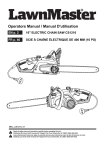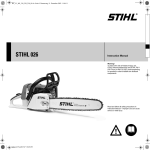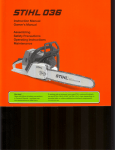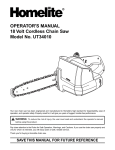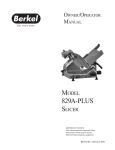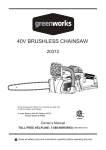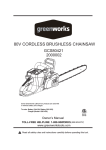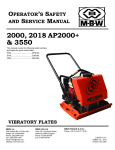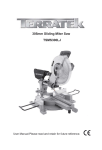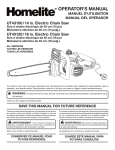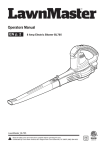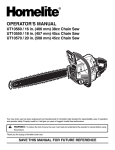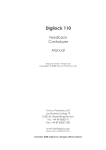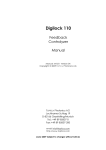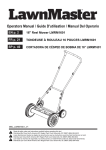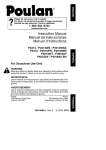Download Operators Manual / Manual D'utilisation
Transcript
Operators Manual / Manual D'utilisation EN p. 2 16" ELECTRIC CHAIN SAW CS1216 FR p. 46 SCIE À CHAÎNE ÉLECTRIQUE DE 406 MM (16 PO) MNL_CS1216_V1 Read all safety rules and instructions carefully before operating this tool. Distributed By Cleva North America 601 Regent Park Court Greenville, SC 29607 (866)-384-8432 Lisez attentivement toutes les règles de sécurité ainsi que les instructions avant de faire fonctionner cet outil. Distribué par Cleva North America 601 Regent Park Court Greenville, SC 29607 (866)-384-8432 TABLE OF CONTENTS CONTENTS 2 2 SPECIFICATIONS IMPORTANT SAFETY INSTRUCTIONS 3-5 GENERAL SAFETY RULES 6-7 SYMBOLS 8-9 ELECTRICAL 10-11 KNOW YOUR CHAINSAW 12-13 ASSEMBLY 14 OPERATION 15-27 MAINTENANCE 28-40 TROUBLESHOOTING 41 WARRANTY 42 EXPLODED VIEW / PARTS LIST 43-44 NOTES 45 SPECIFICATIONS 16’ AC CHAIN SAW CS1216 Rated Voltage: 120 V 60Hz Capacity: 12A Chain Speed(No-load): 12m/s Chain Bar Length: 16 Inch Chain Pitch: 3/8 Inch Oil Tank: 120ml Toolless Chain Tensioning(Sds): Yes Automatic Chain Oiler: Yes Steel Bucking Spikes: Yes Lock-off Button For On/Off Switch: Yes Maximum Cutting Diameter 16inch Oregon Bar 516480 and 112364 Oregon Chain 91PX057 2 IMPORTANT SAFETY INSTRUCTIONS WA R N I N G Do not attempt to operate this tool until you have read all of the instructions, safety information, etc. contained in this manual thoroughly and understand them completely. Failure to comply may result Do not start cutting until you have a clear work area, secure footing, and a planned retreat path from the falling tree. Cluttered areas invite accidents. Keep all children, bystanders, visitors, and animals out of the work area while starting or cutting with the chainsaw. liquids, gases, or dust. Power tools create sparks that may ignite the dust or fumes. WA R N I N G Use outdoor extension cords marked SW-A, SOW-A, STW-A, STOW-A, SJW-A, SJTW-A, or SJTOW-A. These cords are rated for outdoor use, and reduce the risk of electric shock. Polarized Plugs. To reduce the risk of electric shock, this tool has a polarized plug (one blade to install the proper outlet. Do not change the plug in any way. Make sure your extension cord is in good condition. When using an extension cord, be sure to use one heavy enough to carry the current your product will draw. A wire gauge size (A.W.G.) of at least 14 is recommended for an extension cord 50' (15 m) or less in length. A cord exceeding 100' (30 m) is not recommended. If in doubt, use the next heavier gauge. The smaller the gauge number, the heavier the cord. An undersized cord will cause a drop in line voltage, resulting in loss of power and overheating. Inspect extension cords periodically, and if damaged, have repaired by a licensed electrician. Constantly stay aware of cord location. Following this rule will reduce the risk of electric shock cut-resistant material or ones that contain cut-resistant inserts. Wear non-slip safety footwear. Wear non-slip heavy duty gloves to improve your grip and to protect your hands. Do not wear be drawn into the motor or catch the chain or underbrush. Secure hair so it is above shoulder level. Heavy protective clothing may increase operator fatigue, which could lead to heat stroke. During weather that is hot and humid, heavy work should be scheduled for early morning or late afternoon hours, when temperatures are cooler. Wear eye protection that is marked to comply with ANSI Z87.1 as well as hearing and head protection when operating this equipment. Hearing protection should be worn. Always be aware of what you are doing when using the chainsaw. Use common sense. Do medication. 3 IMPORTANT SAFETY INSTRUCTIONS Do not expose the chainsaw to rain. Do not use the chainsaw in damp or wet locations. Stay alert and pay attention to what you are doing. Keep all parts of your body away from the saw chain when the unit is running. Always carry the chainsaw by the front handle with the battery removed and the guide bar and saw chain positioned to the rear. Never let anyone use your chainsaw who has not received adequate instructions in its proper use. This applies to rentals as well as privately owned saws. Before you start the unit, make sure the saw chain is not contacting any object. Stop the chain saw before setting it down. Maintain the unit with care. Keep the cutting edge sharp and clean for best performance and to reduce the risk of injury. Follow instructions for lubricating and changing accessories. Keep handles dry, clean, and free of oil and grease. the chainsaw handles. Serious injury to the operator, helpers, bystanders, or any combination of these persons may result from one-handed operation. A chainsaw is intended for twohanded use. Avoid body contact with grounded surfaces such as metal pipes and wire fences. There is an increased risk of electric shock if your body is grounded. Do not operate a chainsaw that is damaged, improperly adjusted, or not completely and securely assembled. Chain should slow to a stop when the trigger switch is released. If the chain continues to turn after the trigger switch has been released, have the unit serviced by your nearest LawnMaster service dealer. Check for damaged parts, misalignment or binding of moving parts, broken parts and mountings, and any other condition that may affect the operation of the tool. All chainsaw service, other than the items listed in the operation and maintenance sections, should be performed by your nearest LawnMaster service dealer. Always maintain a proper stance. Do not use chainsaw if switch does not turn it on and off. Have defective switch replaced by authorized service centre. Do not adapt your chainsaw to a bow guide or use it to power any attachments or devices not listed for the saw. Disconnect chainsaw from power supply when not in use, before servicing, and when making adjustments and changing attachments, such as saw chain and guard. Do not cut vines and/or small underbrush. Do not operate a chainsaw in a tree, on a ladder, or on scaffolding. Doing so is extremely dangerous. NOTE: The size of the work area depends on the job being performed as well as the size of the tree or workpiece involved. For example, felling a tree requires a larger work area than making bucking cuts. 4 IMPORTANT SAFETY INSTRUCTIONS Use extreme caution when cutting small brush and saplings, because small material may catch the saw chain and be whipped toward you or pull you off balance. When cutting a limb that is under tension, be alert for spring back, so that you will not be Do not force the chainsaw. The job can be performed better if the saw is used at the rate that it was designed to work at. Always use the right product for your application. The chainsaw should be used for cutting wood only. Never use the chainsaw to cut plastic, masonry or non-wooden building materials. Do not use the chainsaw for purposes other than what it is intended for. Store chainsaw when not in use. Chainsaw should be stored in a dry and high or locked area, out of the reach of children. Save these instructions. Refer to them frequently, and use them to instruct others who may use this tool. If you loan someone this tool, also loan them these instructions. WA R N I N G Some dust created by power sanding, sawing, grinding, drilling, and other construction activities contains chemicals known to cause cancer, birth defects or other reproductive harm. Some examples of these chemicals are: lead from lead-based paints crystalline silica from bricks and cement and other masonry products, and arsenic and chromium from chemically treated lumber. Your risk of exposure to these chemicals varies depending on how often you do this type of work. To reduce your exposure to these chemicals, work in a well-ventilated area, and work with particles. SAVE THESE INSTRUCTIONS 5 GENERAL SAFETY RULES KICKBACK (See Fig. 1 - 2.) WA R N I N G Kickback may occur when the moving chain contacts an object at the upper portion of the tip of the guide bar, or when the wood closes in and pinches the saw chain in the cut. Contact at the upper portion of the tip of the guide bar can cause the chain to dig into the object and stop the chain for an instant. The result is a lightning fast reverse reaction that kicks the guide bar up and back toward the operator. If the saw chain is pinched along the top of the guide bar, the guide bar can be driven rapidly back toward the operator. Either of these reactions can cause loss of saw control, which can result in serious injury. Do not rely exclusively on the safety devices built into the saw. As a chainsaw user, you should take several steps to keep your cutting jobs free from accident or injury. THE FOLLOWING PRECAUTIONS SHOULD BE FOLLOWED TO MINIMIZE KICKBACK: 1. unit is running. Place your right hand on the rear handle and your left hand on the front stiff left arm will help you maintain control of the saw if kickback occurs. 2. Make sure that the area in which you are cutting is free of obstructions. Do not let the nose of the guide bar contact a log, branch, fence, or any other obstruction that could be hit while you are operating the saw. 3. Always cut with the unit running. Fully squeeze the trigger switch and maintain cutting speed. 4. manufacturer for the saw. With a basic understanding of kickback, you can reduce or eliminate the element of surprise. Sudden surprise contributes to accidents. Keep proper footing and balance at all times. Do not cut above shoulder height or overreach when cutting. Follow the sharpening and maintenance instructions for the saw chain. ROTATIONAL KICKBACK KICKBACK DANGER ZONE Fig. 1 Fig. 2 6 GENERAL SAFETY RULES 3XVKDQG3XOO²7KLVUHDFWLRQIRUFHLVDOZD\VRSSRVLWHWRWKHGLUHFWLRQWKHFKDLQLVPRYLQJZKHUH contact is made with the wood. Thus, the operator must be ready to control the PULL when cutting on the bottom edge of the bar, and the PUSH when cutting along the top edge. (See Fig. 3) PULL PUSH Fig. 3 7 SYMBOLS Some of the following symbols may be used on this product. Please study them and learn their meaning. Proper interpretation of these symbols will allow you to operate the product better and safer. SYMBOL NAME DESIGNATION/EXPLANATION V Volts Voltage A Amperes Current Hz Hertz Frequency (cycles per second) W Watts Power Minutes Time Alternating Current Type of current Direct Current Type or a characteristic of current No Load Speed Rational speed, at no load Class II Construction Double-insulated construction Per Minute Revolutions, strokes, surface speed, orbits etc., per minute Wet Conditions Alert Do not expose to rain or use in damp locations Read The Operator’s Manual To reduce the risk of injury user must read and understand operator’s manual before using this product. Eye and Head Protection Wear eye and head protection when operating this equipment. Safety Alert Precautions that involve your safety. Operate With Two Hands Hold and operate the saw properly with both hands Kickback DANGER! Beware of kickback. Bar Nose Contact Avoid bar nose contact. Wear Gloves Wear non-slip, heavy-duty protective gloves when handling the chainsaw. Wear Safety Footwear Wear non-slip safety footwear when using this equipment. Keep Bystanders Away Keep all bystanders at least 50 ft. away. min /min 8 SYMBOLS The following signal words and meanings are intended to explain the levels of risk associated with this product. SYMBOL SIGNAL MEANING DANGER Indicates an imminently hazardous situation, which, if not avoided, will result in death or serious injury. WARNING Indicates a potentially hazardous situation, which, if not avoided, could result in death or serious injury. CAUTION Indicates a potentially hazardous situation, which, if not avoided, may result in minor or moderate injury. CAUTION (Without Safety Alert Symbol) Indicates a situation that may result in property damage. SERVICE service technician. For service we suggest you return the product to your nearest AUTHORIZED SERVICE CENTER for repair. When servicing, use only identical replacement parts. WA R N I N G To avoid serious personal injury, do not attempt to use this product until you have read this Owner's Manual thoroughly and understand it completely. If you do not understand the warnings and instructions in this Owner's Manual, do not use this product. Call the Toll-free Helpline (1-866-384843 ) for assistance. The operation of any power tool can result in foreign objects being thrown into your eyes, which can result in severe eye damage. Before operating a power tool, always wear safety goggles, safety glasses with side shields, or a full face shield when needed. We recommend a Wide Vision Safety Mask for use over eyeglasses or standard safety glasses with side shields. Always use eye protection that is marked to comply with ANSI Z87.1. WA R N I N G The operation of any power tool can result in foreign objects being thrown into your eyes, which can result in severe eye damage. Before beginning power tool operation, always wear safety goggles or safety glasses with side shields and, when needed, a full face shield. We recommend Wide Vision Safety Mask for use over eyeglasses or standard safety glasses with side shields. Always use eye protection which is marked to comply with ANSI Z87.1. SAVE THESE INSTRUCTIONS 9 ELECTRICAL WA R N I N G TO AVOID ELECTRICAL HAZARDS, FIRE HAZARDS, OR DAMAGE TO THE TOOL, USE PROPER CIRCUIT PROTECTION. THIS CHAINSAW IS WIRED AT THE FACTORYFOR 120 V OPERATION. CONNECT TO A 120 V, 15 A CIRCUIT, AND USE A 15 A TIME-DELAYED FUSE OR CIRCUIT BREAKER. TO AVOID SHOCK OR FIRE WHEN THE POWER CORD IS WORN, CUT, OR DAMAGED IN ANY WAY, REPLACE IT IMMEDIATELY. DOUBLE INSULATED (See Fig. 4) This chainsaw has a plug that looks like the one shown in Fig. 4. The chainsaw is double insulated to provide a double thickness of insulation between you and the tool’s electrical system. All exposed metal parts are isolated from the internal metal motor components with protective insulation. WA R N I N G TO AVOID INJURY, USE ONLY IDENTICAL CHAINSAW REPLACEMENT PARTS WA R N I N G DOUBLE INSULATION DOES NOT TAKE THE PLACE OF NORMAL SAFETY PRECAUTIONS WHEN OPERATING THIS TOOL. WA R N I N G TO AVOID ELECTRIC SHOCK: 1. Use only identical replacement parts when servicing a tool with double insulation. 2. Do not use in wet or damp areas or expose to rain. C A U T I O N IN ALL CASES, MAKE CERTAIN THE RECEPTACLE IN QUESTION IS PROPERLY GROUNDED. IF YOU ARE NOT SURE, HAVE A CERTIFIED ELECTRICIAN CHECK THE RECEPTACLE. 1) 2-prong plug 2) Properly grounded extension cord 10 Fig. 4 ELECTRICAL WA R N I N G THIS LAWN TOOL IS FOR OUTDOOR USE ONLY. DO NOT EXPOSE TO RAIN OR USE IN DAMP LOCATIONS. GUIDELINES FOR USING EXTENSION CORDS USE THE PROPER EXTENSION CORD. Make sure your extension cord is in good condition. When using an extension cord, be sure to use one of heavy enough gauge to carry the current your product will draw. An undersized cord will cause overheating. The table below shows the correct size to use depending on cord length and nameplate ampere rating. If in doubt, use the next heavier gauge.The smaller the gauge number, the heavier the cord. MINIMUM GAUGE FOR EXTENSION CORDS (AWG) (WHEN USING 120 V ONLY) Amp Rating Total Length of Cord in Feet (meters) More Than Not More Than 25' (7.6 m) 50' (15 m) 0 6 10 12 6 10 12 16 18 18 16 14 16 16 16 12 100' (30.4 m) 150' (45.7 m) 16 14 14 12 14 12 Not Recommended Be sure your extension cord is properly wired and in good condition. Always replace a damaged cords away from sharp objects, excessive heat and damp or wet areas. Use a separate electrical circuit for your tools. This circuit must not be less than 12-gauge cord and should be protected with a 15-amp time delayed fuse. Before connecting the motor to the power line, make sure the switch is in the OFF position and the electric current is rated the same as the current stamped on the motor nameplate. Running at a lower voltage will damage the motor. WA R N I N G THIS TOOL MUST BE GROUNDED WHILE IN USE TO PROTECT THE OPERATOR FROM ELECTRICAL SHOCK. SAVE THESE INSTRUCTIONS 11 KNOW YOUR CHAINSAW SWITCH LOCK TRIGGER SWITCH CLEAR REUSABLE SCABBARD LOW KICKBACK SAW CHAIN METAL BUCKING SPIKES CORD RETAINER FRONT HANDLE FRONT HAND GUARD OIL RESERVOIR CAP REAR HANDLE CHAIN TENSIONING KNOB QUICK VIEW OIL INDICATOR CHAIN COVER CHAIN COVER LOCK KNOB 12 GUIDE BAR Fig. 5 KNOW YOUR CHAINSAW The safe use of this product requires an understanding of the information on the tool and in this Owner's Manual, as well as a knowledge of the project you are attempting. Before using this product, familiarize yourself with all operating features and safety rules. CHAIN TENSIONING KNOB This feature allows user to adjust the tension of the chain. GUIDE BAR The factory-equipped guide bar has a small radius tip that offers a somewhat lower kickback potential. LOW-KICKBACK SAW CHAIN The low-kickback saw chain helps minimize the force of a kickback reaction by preventing the cutters from digging in too deeply at the kickback zone. QUICK-VIEW OIL INDICATOR Semi-transparent oil reservoir that allows user to see when to add oil. SWITCH LOCK A control feature designed to prevent the motor from being started accidentally.. TRIGGER SWITCH Squeeze the trigger switch to operate the unit after switch lock has been pushed in. Release the trigger switch to stop the unit. 13 ASSEMBLY UNPACKING This product has been shipped completely assembled. Carefully remove the product and any accessories from the box. Make sure that all items listed in the packing list are included. Inspect the product carefully to make sure no breakage or damage occurred during shipping. Do not discard the packing material until you have carefully inspected and satisfactorily operated the product. If any parts are damaged or missing, please call 1-866-384-8432 for assistance. PACKING LIST Chainsaw Clear Resuable Scabbard Owner's Manual WA R N I N G If any parts are damaged or missing, do not operate this product until the parts are replaced. Failure to heed this warning could result in serious personal injury. WA R N I N G Do not connect to power supply until assembly is complete. Failure to comply could result in accidental starting and possible serious personal injury. WA R N I N G Do not attempt to modify this product or create accessories not recommended for use with this leading to possible serious personal injury. 14 OPERATION WA R N I N G Do not allow familiarity with this product to make you careless. Remember that a careless fraction WA R N I N G Always wear safety goggles or safety glasses with side shields when operating power tools. Failure to do so could result in objects being thrown into your eyes, resulting in possible serious injury. WA R N I N G Do not use any attachments or accessories not recommended by the manufacturer of this product. The use of attachments or accessories not recommended can result in serious personal injury. APPLICATIONS You can use this product for the purposes listed below: Basic limbing, felling, and woodcutting Removing buttress roots ADDING BAR AND CHAIN LUBRICANT (See Fig. 6) Use standard chainsaw bar and chain Lubricant. It is designed for chains and chain oilers, and is formulated to perform over a wide temperature range with no dilution required. NOTE: The chainsaw comes from the factory with no bar and chain oil added. Level should also be checked after every 20 minutes of use, and refilled as needed. Remove oil cap. Carefully pour the bar and chain oil into the tank. Wipe off excess oil. Repeat as needed. NOTE: Do not use dirty, used or otherwise contaminated oils. Damage may occur to the bar or chain. NOTE: It is normal for oil to seep from the saw when not in use. To prevent seepage, empty the oil tank after each use, then run for one minute. When storing the unit for a long period of time (three months or longer), be sure the chain is lightly lubricated. This will prevent rust on the chain and bar sprocket. 15 OPERATION Fig. 6 Fig. 7 A IN C H IC A N T R LU B OIL RESERVOIR CAP EXTENSION CORD QUICK VIEW OIL INDICATOR CONNECTING TO POWER SUPPLY (See Fig. 7) This chainsaw is designed with a cord retainer that prevents the extension cord from being pulled loose while using. Form a loop with the end of the extension cord. Insert loop portion of extension cord through the opening in the side of the rear handle, and place over cord hitch. Slowly pull loop against cord retainer until the slack is removed. Plug chainsaw into extension cord. NOTE: Failure to remove all excess cord slack from extension cord retainer could result in plug loosening from receptacle. STARTING AND STOPPING THE CHAINSAW (See Fig. 8) WA R N I N G Keep body to the left of the chain line. Never straddle the saw or chain, or lean over past the chain line. 16 OPERATION STARTING THE CHAIN SAW: Make sure chain tension is at desired setting. Refer to Adjusting the Chain Tension in the Maintenance section of this manual. Make sure the chain cover lock knob is tight to the chain cover. Make sure no objects or obstructions are in immediate vicinity which could come into contact with the bar and chain. Press and hold the switch lock. This makes the trigger switch operational. Press and hold the trigger switch, release the switch lock, and continue to squeeze the trigger switch for continued operation. STOPPING THE CHAINSAW: NOTE: It is normal for the chain to coast to a stop once the trigger switch is released. Release the trigger switch to stop the chainsaw. Upon release of the trigger switch, the switch lock will be automatically reset to the lock position. Fig. 8 HANDLE SWITCH LOCK SWITCH TRIGGER 17 OPERATION PREPARING FOR CUTTING PROPER GRIP ON HANDLES (See Fig. 9) See General Safety Rules for appropriate safety equipment. Wear non-slip gloves for maximum grip and protection. your right hand on the rear handle so that your body is to the left of the chain line. encircle the handle, with the thumb wrapped under the handlebar. This grip is least likely to be broken by a kickback or other sudden reaction of the saw. Any grip in which the of the saw can cause loss of control. WA R N I N G Never use a left-handed (cross-handed) grip or any stance that would place your body or arm across the chain line. PROPER HAND GRIP POSITION Fig. 9 WA R N I N G DO NOT operate the trigger switch with your left hand and hold the front handle with your right hand. Never allow any part of your body to be in the chain line while operating a saw. CHAIN LINE 18 OPERATION PROPER CUTTING STANCE (See Fig. 10) Balance your weight with both feet on solid ground. Keep left arm with elbow locked in a “straight arm” position to withstand any kickback force. Keep your body to the left of the chain line. Keep your thumb on underside of handlebar. BASIC OPERATING/CUTTING PROCEDURES Practice cutting a few small logs using the following technique to get the “feel” of using the saw before you begin a major sawing operation. Take the proper stance in front of the wood with the saw idling. Press the switch lock and squeeze the trigger switch, then release switch lock and let the chain accelerate to full speed before entering the cut. Begin cutting with the saw against the log. Keep the unit running the entire time you are cutting, maintain a steady speed. Allow the chain to cut for you; exert only light downward pressure. Forcing the cut could result in damage to the bar, chain, or motor. Release the trigger switch as soon as the cut is completed, allowing the chain to stop. If you run the saw without a cutting load, unnecessary wear can occur to the chain, bar, and unit. Do not put pressure on the saw at the end of the cut. THUMB ON UNDERSIDE OF HANDLE BAR CHAIN LINE Fig. 10 19 STRAIGHT ARM OPERATION WORK AREA PRECAUTIONS (See Fig. 11) Cut only wood or materials made from wood; no sheet metal, no plastics, no masonry, no nonwooden building materials. Never allow children to operate the saw. Allow no person to use this chainsaw who has not read this Owner's Manual or received adequate instructions for the safe and proper use of this chainsaw. Keep everyone – helpers, bystanders, children, and animals – a SAFE DISTANCE from the cutting area. During felling operations, the safe distance should be a least twice the height of the largest trees in the felling area. During bucking operations, keep a minimum distance of 15' (4.6 m) between workers. Always cut with both feet on solid ground to prevent being pulled off balance. kickback forces. Do not fell trees near electrical wires or buildings. Leave this operation for professionals. Cut only when visibility and light are adequate for you to see clearly. Fig. 11 FELLING TREES HAZARDOUS CONDITIONS (See Fig. 12) When felling a tree, it is important that you heed the following warnings to prevent possble serious injury 20 OPERATION TO AVOID KICKBACK 6DZZLWKJXLGHEDUDWDIODWDQJOH 1HYHUZRUNZLWKDORRVHZLGHO\VWUHWFKHGRUWKHKHDYLO\ZRUQRXWFKDLQ (QVXUHFKDLQLVVKDUSHQHGFRUUHFWO\ 1HYHUVDZDERYHVKRXOGHUKHLJKW 1HYHUZRUNZLWKWKHWLSRIWKHJXLGHEDU $OZD\VKROGWKHSURGXFWILUPO\ZLWKERWKKDQGV $OZD\VXVHDORZNLFNEDFNFKDLQ $SSO\WKHVWHHOEXFNLQJVSLNHVIRUOHYHUDJH (QVXUHFRUUHFWFKDLQWHQVLRQ 'RRQO\FXWZLWKWKHPRWRUDWKLJKVSHHGV 'RQRWOHWWKHQRVHRIWKHJXLGHEDUFRQWDFWDORJEUDQFKRUDQ\RWKHUREVWUXFWLRQZKLFKFRXOG be hit while you are operating the product. )ROORZPDQXIDFWXUHU¶VVKDUSHQLQJDQGPDLQWHQDQFHLQVWUXFWLRQVIRUWKHDZFKDLQ 2QO\XVHUHSODFHPHQWJXLGHEDUVDQGVDZFKDLQVVSHFLILHGE\WKHPDQXIDFWXUHURUHTXLYDOHQW replacements. When bucking and felling operations are being performed by two or more persons at the same time, the felling operations should be separated from the bucking operation by a distance of at least twice the height of the tree being felled. Trees should not be felled in a manner that would endanger any person, strike any utility line or cause any pro perty damage. If the tree does make contact with any utility line, the company should be notified immediately. The product operator should keep on the uphill side of the terrain as the tree is likely to roll or slide downhill after it is felled. 21 OPERATION PLANNED LINE OF FALL PLANNED LINE OF FALL PATH OF SAFE RETREAT 45° 90° 45° 135° 90° 135° FROM PLANNED LINE OF FALL 135° PATH OF SAFE RETREAT Fig. 12 Do not cut down trees having an extreme lean, or large trees with rotten limbs, loose bark or hollow trunks. Have these trees pushed or dragged down with heavy equipment, then cut them up. Do not cut trees near electrical wires or buildings Check the tree for damaged or dead branches that could fall and hit you during felling Periodically glance at the top of the tree during the backcut to assure the tree is going to fall in the desired direction If the tree starts to fall in the worng direction, or if the saw gets caught or hung up during the fall, leave the saw and save yourself! WA R N I N G Do not fell trees during periods of high wind or heavy precipitation. Wait until the hazardous weather has ended. PROPER PROCEDURE FOR TREE FELLING (See Fig. 13) Felling a treH²When bucking and felling operations are being perfrmed by two or more persons at the same time, the felling operations should be separated from the bucking operation by a distance of at least twice the height of the tree being felled. Trees should not be felled in a manner that would endanger any person, strike any utility line, or cause any property damage. If the tree does make contact with any utility line, the utility company hould Operator should keep on the uphill side of terrain as the tree is likely to roll or slide after it is felled. Pick your escape route (or routes in case the intended route is blocked). Clear the immediate area around the tree and make sure there are no obstructions in your planned path of retreat. Clear the path of safe retreat approximately 135° from the planned line of fall. 22 OPERATION An escape path should be planned and cleared as necessary before cuts are started. The escape path should extend back and diagonally to the rear of the expected line of fall (Fig. 26). Before felling is started, consider the natural lean of the tree, the location of larger branches and the wind direction to judge which way the tree will fall. Fig.13 NOTCHING UNDERCUT Make the notch (B) 1/3 the diameter of the tree, perpendicular to the direction of falls (Fig. 13). Make the lower horizontal notching cut first. This will help to avoid pinching either the saw chain or the guide bar when the second notch is being made. FELLING BACK CUT Make the felling back cut (A) at least 50 mm higher than the horizontal notching cut (Fig. 13). Keep the felling back cut parallel to the horizontal notching cut. Make the felling back cut so enough wood is left to act as a hinge. The hinge wood keeps the tree from twisting and falling in the wrong direction. Do not cut through the hinge. As the felling gets close to the hinge, the tree should begin to fall. If there is any chance that the tree may not fall in desired direction or it may rock back and bind the saw chain, stop cutting before the felling back cut is complete and use wedges of wood, plastic or aluminium to open the cut and drop the tree along the desired line of fall. When the tree begins to fall remove the product from the cut, stop the motor, put the product down, then use the retreat path planned. Be alert for overhead limbs falling and watch your footing. Limbing is removing the branches from a fallen tree. When limbing leave larger lower limbs to support the log off the ground. Remove the small limbs in one cut . Branches under tension should be cut from the bottom up to avoid binding the product. 23 OPERATION REMOVING BUTTRESS ROOTS (See Fig. 14) A buttress root is a large root extending from the trunk of the tree above the ground. Remove vertical cut. Remove the resulting loose section from the work area. Follow the correct tree felling procedure as stated in Proper Procedure For Tree Felling after you have removed the large buttress roots. BUCKING (See Fig. 15) Bucking is the term used for cutting a fallen tree to the desired log length. Always make sure your footing is secure and your weight is distributed evenly on both feet. Cut only one log at a time. Support small logs on a saw horse or another log while bucking. Keep a clear cutting area. Make sure no objects can contact the guide bar nose and chain during cutting, because this can cause kickback. When bucking on a slope, always stand on the uphill side of the log. To maintain complete control of the chainsaw when cutting through the log, release the cutting pressure near the end of the cut without relaxing your grip on the chainsaw handles. Do not let the chain contact the ground. After completing the cut, wait for the saw chain to stop before you move the chainsaw. Always stop the motor before moving from tree to tree. Fig. 14 Fig. 15 KICKBACK VERTICAL CUT LOOSE SECTION HORIZONTAL CUT 24 OPERATION BUCKING WITH A WEDGE (See Fig. 16) If the wood diameter is large enough for you to insert a soft bucking wedge without touching the chain, you should use the wedge to hold the cut open to prevent pinching. BUCKING LOGS UNDER STRESS (See Fig. 17) side. As you cut the log, it will tend to bend. The saw can become pinched or hung in the log if under stress to prevent the bar and chain from pinching. OVERBUCKING (See Fig. 18) Begin on the top side of the log with the bottom of the saw against the log; exert light pressure downward. Note that the saw will tend to pull away from you. UNDERBUCKING (See Fig. 19) Begin on the under side of the log with the top of the saw against the log; exert light pressure upward. During underbucking, the saw will tend to push back at you. Be prepared for this Fig. 16 LOG SUPPORTED AT ONE END LOAD FINISHING CUT Fig. 17 WEDGE 1ST CUT 1/3 DIA LOG SUPPORTED AT BOTH ENDS 1ST CUT 1/3 DIA LOAD FINISHING CUT OVERBUCKING UNDERBUCKING Fig. 18 Fig. 19 25 OPERATION LIMBING (See Fig. 20) Limbing is removing branches from a fallen tree. footing is secure and your weight is distributed evenly on both feet. Leave the larger support limbs under the tree to keep the tree off the ground while cutting. Limbs should be cut one at a time. Remove the cut limbs from the work area often to help keep the work area clean and safe. Branches under tension should be cut from the bottom up to avoid binding the chainsaw. Keep the tree between you and the chainsaw while limbing. Cut from the side of the tree opposite the branch you are cutting. PRUNING (See Fig. 21) Pruning is trimming limbs from a live tree. footing is secure and your weight is distributed evenly on both feet. Do not cut from a ladder. This is extremely dangerous. Leave this operation for professionals. kickback. until you have cut off the limb further out to reduce the weight. This prevents stripping the bark from the main member. Your second cut should overbuck to drop the branch off. grow back to seal the wound. WA R N I N G Never cut through to the notch when making a back cut. The hinge controls the fall of the tree. This is the section of wood between the notch and backcut. 26 OPERATION LOAD SECOND CUT FIRST CUT 1/3 DIA FINISHING CUT Fig. 20 CUT LIMBS ONE AT A TIME AND LEAVE SUPPORT LIMBS UNDER TREE UNTIL LOG IS CUT Fig. 21 CUTTING SPRINGPOLES (See Fig. 22) A springpole is any log, branch, rooted stump, or sapling that is bent under tension by other wood, so that it springs back if the wood holding it is cut or removed. On a fallen tree, a rooted stump has a high potential of springing back to the upright position during the bucking cut to separate the log from the stump. WDWFKRXWIRUVSULQJSROHV²WKH\DUHGDQJHURXV WA R N I N G Springpoles are dangerous, and could strike the operator, causing the operator to lose control of the chainsaw. This could result in severe or fatal injury to the operator. SPRINGPOLE Fig. 22 27 MAINTENANCE WA R N I N G When servicing, use only identical LawnMaster replacement parts OR suggested replacement parts by LawnMaster. Use of any other parts may create a hazard or cause product damage. WA R N I N G Always wear safety goggles or safety glasses with side shields during power tool operation or when blowing dust. If operation is dusty, also wear a dust mask. GENERAL MAINTENANCE Avoid using solvents when cleaning plastic parts. Most plastics are susceptible to damage from various types of commercial solvents. Use a clean cloth to remove dirt, dust, lubricant, grease, etc. WA R N I N G contact with plastic parts at any time. Chemicals can damage, weaken or destroy plastic, which may result in serious personal injury. LUBRICATION for the life of the unit under normal operating conditions. Therefore, no further lubrication is required. 28 MAINTENANCE Switch the product off, remove the battery pack and let it cool down Check, clean and store the product as described below Keep the product clean. Remove debris from it after each use and before storage. Regular and proper cleaning will help ensure safe use and prolong the life of the product. Inspect the product before each use for worn and damaged parts. Do not operate it if you find broken and worn parts. GENERAL CLEANING Clean the product with a slightly damp cloth and mild soap. Use a brush for areas that are hard to reach. In particular clean the air vents (4) after every use with a cloth and brush. Remove stubborn dirt with high pressure air (max. 3 bar). Check for any damage and wear. Repair damages in accordance with this instruction manual or take it to an authorised service centre before using the product again. SPROCKET NOSE C Clean the sprocket nose (7). Using a disposable lube gun, insert the needle nose into the lubrication hole (C) and inject grease until it appears at the outside edge of the sprocket (Fig. 23). Rotate the saw chain (5) by hand. Repeat the lubrication procedure until the entire sprocket has been greased. Fig.23 GUIDE BAR AND SAW CHAIN MAINTENANCE Most guide bar problems can be prevented merely by keeping the product well maintained. Incorrect filing and non-standard cutter and depth gauge settings are the causes of most guide bar problems, primarily resulting in uneven bar wear. As the bar wears unevenly, the rails widen, which may cause the chain to clatter and make it difficult to complete straight cuts. If the guide bar is insufficiently lubricated and the product is operated with a saw chain which is too tight, this will contribute to rapid bar wear. To help minimise bar wear, maintenance of the guide bar as well as the saw chain is recommended. Disassemble the guide bar and saw chain in >>reversed order from assembly. Check the oiling port (16) for clogging and clean >>if necessary to ensure proper lubrication of the guide bar and saw chain during operation. Use a soft wire small enough to insert into the oil discharge hole 29 MAINTENANCE REPLACING THE GUIDE BAR AND CHAIN (See Fig. 24 - 32.) D A N G E R Never start the motor before installing the guide bar, chain, chain cover, and chain cover lock knob. serious injury. WA R N I N G To avoid serious personal injury, read and understand all the safety instructions in this section. WA R N I N G Before performing any maintenance, make sure the tool is unplugged from the power supply. Failure to heed this warning could result in serious personal injury. C A U T I O N Always wear gloves when handling the bar and chain. These components are sharp and may contain burrs. WA R N I N G Never touch or adjust the chain while the motor is running. The saw chain is very sharp. Always wear protective gloves when performing maintenance involving the chain to avoid possible serious lacerations. Bar and Chain Combinations section later in this manual. 30 MAINTENANCE WARNING Keep all parts of the body away from the saw chain when the chain saw is operating. Before you start the chain saw, make sure the saw chain is not contacting anything. A moment of inattention while operating chain saws may cause entanglement of your clothing or body with the saw chain. WARNING Always hold the chain saw with your right hand on the rear handle and your left hand on the front handle. Holding the chain saw with a reversed hand configuration increases the risk of personal injury and should never be done. WARNING Always use a saw chain designed as “low-kickback” or a saw chain which meets the low-kickback requirements! A standard saw chain (a chain which does not have the kickback reducing guard links) should only be used by an experienced professional operator! Nevertheless, a low-kickback saw chain does not completely eliminated kickback! A low-kickback or “safety” chain should never be regarded as complete protection against injury! Therefore always use a low-kickback saw chain in conjunction with other kickback protection devices such as the front hand guard! Use only the guide bar (6) and saw chain (5) according to the technical data of the product. Place the product on a suitable flat surface. Loosen the locking wheel (9) and remove the side cover (10) (Fig. 24). Spread the saw chain (5) out with the cutting edges of the chain pointing in the rotational direction 5 6 10 9 Fig.24 31 Fig.25 MAINTENANCE SAW CHAIN TENSIONING Always check the saw chain tension before use and regularly during use approx. every five cuts. Upon initial operation, new chains can lengthen considerably. This is normal during the break-in period and the interval between future adjustments will lengthen quickly. SET THE PRODUCT ON A SUITABLE FLAT SURFACE. Turn the tension wheel (8) until the chain “tie straps” are just touching the bottom edge of the guide bar (6) (Fig. 26). 8 6 Fig. 26 TENSION TEST Check the chain tension using one hand to lift the saw chain (5) against the weight of the product. The correct chain tension is achieved when the saw chain can be lifted by approximately 2 - 4 mm from the guide bar (6) in the centre (Figs. 27-28). Adjust the tension if you find that the chain saw is too loose or tight 2-4mm Fig. 27 Fig. 28 32 MAINTENANCE Ensure the tension disc (6b) is adjusted to outer right position, turn anticlockwise if required (Figs. 29-30). Fig. 29 Fig. 30 Align the guide bar (6) and saw chain (5) assembly with the drive sprocket (19) and support bolt (17). Lay the saw chain around the drive sprocket and then lower the guide bar to install it to the support bolt (Figs. 31-32). Fig. 31 Fig. 32 Replace the side cover (10) and slightly tighten the locking wheel (9) (Fig. 33). Do not tighten the locking wheel completely; saw chain tensioning is required first. 10 9 Fig. 33 33 MAINTENANCE CUTTERS CHAIN ROTATION CHAIN DRIVE LINKS Fig. 36 Fig. 34 BAR GROOVE CHAIN DRIVE LINKS Fig. 35 Fig. 37 Release the tip of the guide bar, and turn the chain tensioning knob 1/2 turn clockwise. Hold the tip of the guide bar up and tighten the chain cover lock knob. The chain is correctly tensioned when there is no sag on the underside of the guide bar, and when the chain is snug, but can be turned by hand without binding. NOTE: If chain is too tight, it will not rotate. Loosen the chain cover lock knob slightly, and turn the chain tensioning knob 1/4 turn counter-clockwise. Lift the tip of the guide bar up, and retighten the chain cover lock knob. Ensure that the chain will rotate without binding. WA R N I N G Never touch or adjust the chain while the motor is running. The saw chain is very sharp. Always wear protective gloves when performing maintenance involving the chain. 34 MAINTENANCE Turn the chain tensioning knob clockwise to tension the chain. NOTE: A cold chain is correctly tensioned when there is no slack on the underside of the guide bar, the chain is snug, and it can be turned by hand without binding. on the drive links hang out of the bar groove. NOTE: During normal saw operation, the temperature of the chain increases. The drive links of a correctly tensioned warm chain will hang approximately 1/16" (1.3 mm) out of the bar groove. NOTE: New chains tend to stretch. Check the chain tension frequently and tension as required. C A U T I O N A chain tensioned while warm may be too tight upon cooling. Check the “cold tension” before next use. FLATS ON DRIVE LINKS Fig. 38 § .050 in. Fig. 39 35 MAINTENANCE Turn the locking wheel (9) to tighten the side >>cover (10) completely (Fig. 40). Fig. 40 9 Do not overfill. Leave approximately 5 mm of space to the lower edge to allow the lubricant to expand (Fig. 41). Check the oil level at the window of the oil tank (11) prior to switching on and regularly during operation. Refill oil when the oil level is lower than the “MIN” marking (Fig. 42). Wipe up spilled lubricant with a soft cloth and refit the tank cap (11a). 11a Fig. 41 11 Fig. 42 ake sure the guide bar (6) and the saw chain (5) are in place when you check the oil delivery. Switch on the product (see section “on/off switch” below); keep pressing the on/off switch (13) and check if the chain oil is delivered as shown in the figure (Fig. 43) Fig. 43 36 MAINTENANCE CARE AND MAINTENANCE Check the drive sprocket (19). If it is worn or damaged due to strain, have it replaced by an authorised service agent. Clear residue from the rails on the guide bar (6) using a screwdriver, putty knife, wire brush or other similar tool. This will keep the oil passages open to provide proper lubrication to the bar (6) and chain (5) . Check the guide bar ‘rail’ for wear: Hold a ruler (straight edge) against the side of the guide bar and ‘cutter side plates’. If there is a gap between the ruler and guide bar the guide bar ‘rail’ is normal. If there is no gap (ruler flush against the side of the guide bar) the guide bar ‘rail’ is worn and needs to be replaced with a new one of the same type . Turn the guide bar 180° to allow even wear, thereby extending the life span of the guide bar (6). Loosen the screw and remove the tension disc (6b) from the guide bar. Ensure the rubber washer on the screw is free of wear. Turn the guide bar and fix the tension disc with the screw. Apply a drop of suitable glue to the screw to ensure its safe positioning when reassembly. 37 MAINTENANCE C A U T I O N Make sure the chainsaw is disconnected from the power supply before you work on the saw. CHAIN MAINTENANCE (See Fig. 44) Use only a low-kickback chain on this saw. This fast-cutting chain provides kickback reduction when properly maintained. For smooth and fast cutting, maintain the chain properly.The chain requires sharpening when the wood chips are small and powdery, the chain must be forced through the wood during cutting, or the chain cuts to one side. During maintenance of the chain, consider the following: Raker (depth gauge) clearance. Too low increases the potential for kickback. Not low enough decreases cutting ability. If the cutter teeth hit hard objects such as nails and stones, or are abraded by mud or sand on the wood, have an authorized service centre sharpen the chain. NOTE: Inspect the drive sprocket for wear or damage when replacing the chain. If signs of wear or damage are present in the areas indicated, have the drive sprocket replaced by an authorized service centre. NOTE: If you do not fully understand the correct procedure for sharpening the chain after reading the instructions that follow, have the saw chain sharpened by an authorized service centre or replace with a recommended low-kickback chain. RAKER (DEPTH GAUGE) CLEARANCE .025 in. Fig. 44 38 MAINTENANCE Check the saw chain for possible wear and damages. Replace it with a new one if required. Experienced user can sharpen a dull saw chain (see section “Saw chain sharpening” below). Refit the saw chain (5) and the guide bar (6) as described under “Assembly”. SAW CHAIN SHARPENING Have your chain (5) sharpened professionally at an authorised service centre, or sharpen the chain yourself by using a proper sharpening kit. Also observe the sharpening instructions supplied with the sharpening kit. The height difference between the tooth and the ridge is the cutting depth. When sharpening the saw chain (5) you have to consider the following points )LOHDQJOH &XWWLQJDQJOH )LOHSRVLWLRQ 'LDPHWHURIURXQGILOH )LOH To sharpen the chain proceed as follows: 8VHSURWHFWLYHJORYHV (QVXUHWKHFKDLQLVFRUUHFWO\WHQVLRQHG (QJDJHWKHFKDLQEUDNHWRORFNWKHFKDLQRQWKHEDU Use a round file, whose diameter is 1.1 times the cutting tooth depth. Make sure 20% of the file diameter is above the cutter’s top plate. A file guide is available from most reputable tool merchants and is the easiest way to hold the file at the correct position. File at an angle perpendicular to the bar, and at an angle of 25° to the direction of travel File each tooth from the inside towards outside only. File one side of the chain first than turn the saw around and repeat the process. Sharpen each tooth equally by using the same number of strokes. Keep all cutter lengths equal. Check the safety depth gauge height every 5 sharpenings. If the depth gauges are also trimmed it is essential that the original profile is restored. Use a depth gauge measuring >>instrument to check the height of the depth gauge. Depth gauge measuring jigs are available from most reputable tool merchants 39 MAINTENANCE This product does not contain any parts that can be repaired by the consumer. Contact a qualified specialist to have it checked and repaired. lean the product as described above. STORAGE Store the product and its accessories in a dry, frost-free place. Always store the product in a place that is inaccessible to children. The ideal storage temperature is between 10 and 30°C. We recommend using the original package for storage or covering the product with a suitable cloth or enclosure to protect it against dust. TRANSPORTATION Switch the product off and remove the battery pack before transporting it anywhere. Attach the blade cover to the saw blade. Attach other transportation guards, if applicable. Always carry the product by its gripping handles (1, 2). Protect the product from any heavy impact or strong vibrations which may occur during transportation in vehicles. Secure the product to prevent it from slipping or falling over. 40 TROUBLESHOOTING PROBLEM CAUSE REMEDY Bar and chain running Check chain tension for over-tight condition. Plug in the power cord. hot and smoking. Chain-oil tank empty. Motor runs, but chain Chain tension too tight. Retension chain, Refer to A d j u s t i n g C h a i n Te n s i o n earlier in this manual. Check guide bar and chain assembly. Refer to Replacing Bar and Chain earlier in this manual. Check guide bar and chain for damage. Inspect guide bar and chain for damage. Dull chain. Sharpen chain. Chain on backwards. Reverse direction of chain. is not rotating. Motor runs,chain rotates but does not cut. 41 WARRANTY We take pride in producing a high quality, durable product. This Lawnmaster® product carries a limited two (2) year warranty against defects in workmanship and materials from date of purchase under normal household use. If product is to be used for commercial, industrial or rental use, a 30 day limited warranty will apply. Batteries carry a one-year warranty against defects in workmanship and materials. Batteries must be charged in accordance with the operator's manual directions and regulations in order to be valid. Warranty does not apply to defects due to direct or indirect abuse, negligence, misuse, accidents, repairs or alterations and lack of maintenance. Please keep your receipt/packing list as proof of purchase. This warranty gives you specific legal rights, and you may have other rights, which vary from state to state. For product service call Customer Service at (866) 384-8432. Items not covered by warranty : 1. Any part that has become inoperative due to misuse, commercial use, abuse, neglect, accident, improper maintenance, or alteration; 2. The unit, if it has not been operated and/or maintained in accordance with the owner's manual; 3. Normal wear, except as noted below; 4. Routine maintenance items such as lubricants, blade sharpening; 5. Normal deterioration of the exterior finish due to use or exposure. Transportation Charges : Transportation charges for the movement of any power equipment unit or attachment are the responsibility of the purchaser. It is the purchaser’s responsibility to pay transportation charges for any part submitted for replacement under this warranty unless such return is requested in writing by LawnMaster. SAVE YOUR RECEIPTS. THIS WARRANTY IS VOID WITHOUT THEM. 42 EXPLODED VIEW / PARTS LIST 43 EXPLODED VIEW / PARTS LIST CS1216 Manual Parts List Key Number Drawing Number 1 171-7J13002 2 196-7J11601 3 293-7J13001 4 293-7J13002 5 235-7J13001 6 324-7J13001 7 139-7J13001 8 297-7J13001 9 216-7J13001 10 303-7J13001 11 324-7J13002 12 324-7J13003 13 324-7J13004 14 313-7J11203 15 324-7J13005 16 372-1610 17 324-7J13006 18 303-7J13002 19 324-7J13006 Description Quantity 1 44 NOTES 45













































